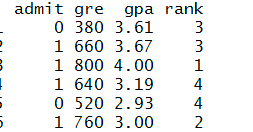My question is how to perform TukeyHSD multiple comparison on ratio(for example, conversion rate, graduate school admit rate) using multcomp package in R. Take UCLA admission data for example:
mydata <- read.csv("http://www.ats.ucla.edu/stat/data/binary.csv")
mydata$rank <- factor(mydata$rank)
head(mydata)

admit=1 means admitted. So if I am going to multi-pair comparison of admission rate(sum(admit)/count(admit)) between "rank", can I do it as what COOLSerdash proposed in the link: Comparing levels of factors after a GLM in R
mydata <- read.csv("http://www.ats.ucla.edu/stat/data/binary.csv")
mydata$rank <- factor(mydata$rank)
my.mod=glm(admit~rank, data=mydata,family=quasibinomial)
my.mod.mc=glht(my.mod, mcp(rank="Tukey"))
summary(my.mod.mc)
Simultaneous Tests for General Linear Hypotheses
Multiple Comparisons of Means: Tukey Contrasts
Fit: glm(formula = admit ~ rank, family = quasibinomial, data = mydata)
Linear Hypotheses:
Estimate Std. Error z value Pr(>|z|)
2 - 1 == 0 -0.7500 0.3095 -2.423 0.0709 .
3 - 1 == 0 -1.3647 0.3371 -4.049 <0.001 ***
4 - 1 == 0 -1.6867 0.4114 -4.100 <0.001 ***
3 - 2 == 0 -0.6147 0.2758 -2.229 0.1127
4 - 2 == 0 -0.9367 0.3628 -2.582 0.0473 *
4 - 3 == 0 -0.3220 0.3866 -0.833 0.8357
If that's the case, how to interpret "Estimate" field?
thanks,
Kyle
